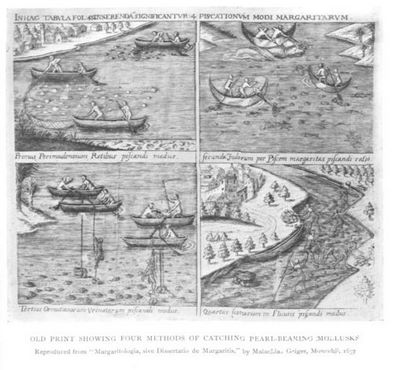|
Pearling Methods Around the WorldPearling is discussed in this article from Kunz and Stevenson in their book published in 1908.  Pearling Methods According to a report furnished by the Mining Bureau at Manila, there were seven vessels fishing with diving-suits in the Sulu Archipelago in 1905, each representing an investment of about 6000 pesos. In 1906 there were ten vessels engaged in this industry, and the collection on licenses for that fiscal year amounted to 3375 pesos. These vessels were mostly small Moro craft which cannot venture upon distant cruises in the Archipelago for prospecting purposes, and their operations are confined for the most part to the immediate vicinity of Jolo. Each vessel carries one diver, a tender, a cook and four sailors. In addition to food supplies, the sailors and the cook each receive twelve to fifteen pesos per month, the tender thirty to forty pesos per month, and the diver the same amount and in addition thereto a bonus of twenty cents for each shell secured. Near Jolo the vessels work throughout the year, but further north very little fishing is done from December to April, when monsoons prevail. The man in charge of each vessel is obliged by law to keep an accurate record of the number and weight of shells found, and his figures are checked up by a customs official at either Jolo or Zamboanga, the ports of discharge. To enable them to secure pearl-oysters at depths of from twenty to forty fathoms, the Sulus have long made use of a dredge (badja) peculiarly constructed of native materials, and admirably adapted to the purpose. This consists of five or more long wooden teeth slightly curved and spreading outward, with an expanse at the ends of twenty inches or more. The dredge is properly balanced by two stones, and a bridle rope is so attached to it that, when thrown overboard and towed behind a canoe drifting with the current or the wind, the implement rests on the curve of the teeth, which are in almost a horizontal position. As the teeth enter the gaping shell of an oyster lying on the bottom, the animal quickly closes instantly closes tightly on the intruder and effects its own capture. The principle is similar to that of the ‘crow-foot’ dredge of the Mississippi River, although the design of the implement is radically different. A second rope is attached so as to raise and lower the instrument and to detach it from corals, rocks, and other objects against which it may catch in its course on the bottom. This dredge is designed for very deep areas, where the bottom is relatively smooth. The Moros employ yet another method of fishing, using a mag-tung-tung or three pronged catcher, which is let down by a rattan rope and by means of which individual shells sighted from the surface are obtained. When the water is perfectly clear this implement can be operated where the water is clouded or there is even s slight ripple on the surface. However, the bulk of the catch is made by the nude divers, of which there are hundreds at Maimbun, Tapul, Lugus and elsewhere. In their small boats these Moro fishermen visit the reefs, where the boats are anchored. Provided only with a short, heavy knife, with which to release the shell from the bottom or, perchance, as a weapon of defense against sharks or other fish, they enter the water feet first, but soon turn and descend head downward, precisely as on the Australian coast, swimming toward the bottom with bold strokes. The Sulu divers—and especially those at Parang, Patian and Sicubun—are among the most expert in the world. They easily penetrate to twelve fathoms and, if necessary, to eighteen or twenty fathoms. But they are not very industrious, and seldom descend more than twelve to fifteen times a day, preferring rather to go with their wants half satisfied than to satiate them by more active exertions. Many descents may be necessary to locate and obtain a single oyster, but when this is secured the shell alone may ordinarily be traded for sufficient to supply the fisherman’s needs for several days, and there is always the chance of a gem. After a short day of labor, the fishermen may return, and the oysters which they have secured are opened and examined for pearls. After the flesh has been carefully searched it is placed in the sun to dry and, later, to be used for food, and the shells are carefully cleaned and placed under cover until they may be bartered or sold. |











